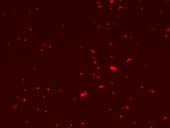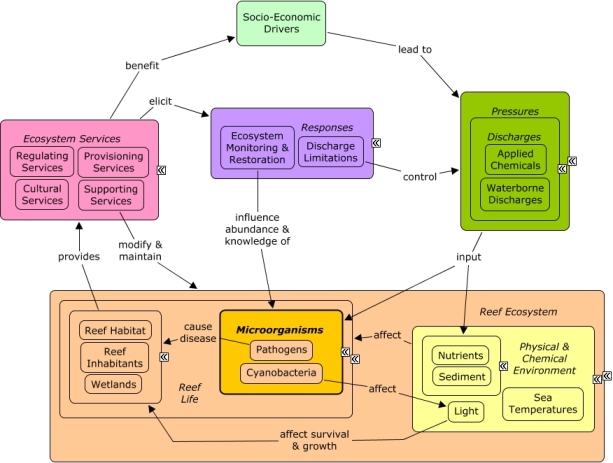ReefLink Database

Cyanobacteria
Cyanobacteria (also known as blue-green algae) obtain their energy through photosynthesis. The name "cyanobacteria" comes from the color of the bacteria. Aquatic cyanobacteria are probably best known for the extensive and highly visible blooms that can form in both freshwater and the marine environment and can have the appearance of blue-green paint or scum. The association of toxicity with such blooms has frequently led to the closure of recreational waters when blooms are observed. Cyanabacteria blooms can cause coral disease.
CMap

CMap Description
Biological inputs of pathogens through wastewater discharges can cause disease in native species. Pathogen growth and disease outbreaks may be accelerated in elevated sea surface temperatures. Periodic cyanobacteria blooms may be related to elevated nutrient levels, and can alter light availability or produce toxic chemicals. Changes in reef condition can affect the availability of goods and services. Many of the same socio-economic sectors that benefit from reef ecosystem goods and services also create pressures on reefs through wastewater discharges. Monitoring and scientific research can be used to track cyanobacteria blooms and disease outbreaks, and to better understand their impact on reef species. Discharge limitations can control the intensity and frequency of discharges, reducing inputs of nutrients and potential pathogens into the environment.Citations
More than 50 citations. Click here to load.
| Citation | Year | Study Location | Study Type | Database Topics |
|---|
Management Options
| Management Option | Description | Sources | Database Topics |
|---|---|---|---|
| Monitor & Research: Biological Status and Trends Monitoring | This activity produces long-term comprehensive information on sanctuary-wide status and trends of biological resources. Data that could be collected on coral reef communities includes but is not limited to species abundance and density, biodiversity, benthic cover, coral condition, growth, recruitment, predation, and grazing. Mangroves and seagrasses should also be monitored. With adequate baseline data, changes in community structure and biocriteria can be identified and restoration or protection efforts can be taken. | NOAA Marine Sanctuary Program. 2007. Florida Keys National Marine Sanctuary revised management plan. National Ocean Service, Key West, FL. |
Algae; Anemones & Zooanthids; Apex Fish Predators; Aquaculture; Aquarium Stock; Biochemical & Genetic Resources; Biocriteria; Biological Harvest; Biological Monitoring & Restoration; Biological Monitoring, Mapping, & Scientific Research; Bivalves; Calcareous Macroalgae; Contact Uses; Coral; Coralline Algae; Cyanobacteria; Decision Support; Echinoderms; Ecosystem Monitoring & Restoration; Finfish & Shellfish Stock; Fish; Fishing Sector; Food & Energy Policies; Hydrocoral; Invasive Species; Invertebrates; Large Herbivorous Fish; Lobster, Crab, & Shrimp; Mangroves; Marine Birds; Marine Products; Marine Vertebrates; Marine Worms; Microorganisms; Molluscs; Octocoral; Octopus & Squid; Ornamental Jewelry & Art; Pathogens; Pharmaceuticals & Cosmetics Sources; Physical Damage; Primary Production; Provisioning Services; Resource Use Management; Sea Turtles; Sea Urchins; Seagrasses; Seastars; Skeletal Coral; Small Herbivorous Fish; Snails & Conch; Sponges; Stony Coral; Tunicates; Wetlands; Whales & Dolphins |
| Resource Use Management: Develop Regulations for Sponge Fisheries | Sponges play a vital role on reefs, providing structure, food and filtration. Depending on the method of removal, this process can be very destructive to other reef fauna and habitat. Research is needed to compare impacts of different sponge fishing methods in different areas. | NOAA Marine Sanctuary Program. 2007. Florida Keys National Marine Sanctuary revised management plan. National Ocean Service, Key West, FL. |
Accidental & Illegal Harvest; Biochemical & Genetic Resources; Biological Harvest; Biological Monitoring, Mapping, & Scientific Research; Boring Sponges; Commercial Fisheries; Contact Uses; Culture; Cyanobacteria; Educational & Research Opportunities; Encrusting Sponges; Finfish Harvest; Fisheries & Hunting Policies; Fishing & Harvesting Management; Fishing Sector; Invertebrate Harvest; Live Collection; Marine Products; Microorganisms; Nutrient & Contaminant Processing; Pharmaceuticals & Cosmetics Sources; Physical Damage; Resource Use Management; Scientific Research; Sponges; Tourism & Recreation; Tourism & Recreation Policies; Trawling & Fishing Gear Damage; Tube, Barrel, & Finger Sponges |
| Water Quality Management: Reduce Pollution & Discharges from Marinas & Live-Aboards | This management option strives to reduce and eliminate the discharge of wastewater and pollution within zones near corals. In many instances, "no-discharge" zones already exist and are simply poorly enforced. In other instances the discharge limits are not stringent enough. Successful regulation requires marinas to be equipped with the proper infrastructure to support transfer of wastewater from vessels to shore-side for treatment. This infrastructure includes: pump-out facilities and mobile pump-out services. | NOAA Marine Sanctuary Program. 2007. Florida Keys National Marine Sanctuary revised management plan. National Ocean Service, Key West, FL. |
Biological Addition; Boating Activities; Boating Regulations; Coastal Engineering; Cyanobacteria; Discharge Limitations; Discharges; Docks & Marinas; Health; Health Policies; Marine Debris; Microorganisms; Nutrient & Contaminant Processing; Nutrients; Pathogens; Physical Damage; Point & Mobile Source Controls; Point Source Discharges; Ports & Harbors; Resource Use Management; Sewage Treatment; Solid Waste Disposal; Waste Management; Waste Management Policies; Wastewater Discharge; Waterborne Discharges |
| Water Quality Management: Pet Waste Cleanup Ordinance & Education | In residential areas, pet waste can contributes to the large amount of nutrients and pathogens that enter the water through stormwater runoff. This is especially useful in regions such as Gu�nica, Puerto Rico where there are a lot of stray dogs. Education for pet-owners and possible ordinance would help decrease harmful pathogens reaching corals through stormwater runoff and reduce eutrophication. | Center for Watershed Protection. 2008. Guanica Bay watershed management plan. Natural Resources Conservation Service. Animal Waste Collection. Urban BMP's - Water Runoff Management Accessed 3/18/2011. Clary, J., Leisenring, M., and Jeray, J. 2010. International Stormwater Best Management Practices (BMP) Database. Pollutant Category Summary: Fecal Indicator Bacteria. Wright Water Engineers. |
Aquarium & Pet Trade; Biological Addition; Chemical Variables; Cultural Policies; Cultural Services; Culture; Cyanobacteria; Discharge Limitations; Discharges; Domestic Animal Waste; Environmental Education & Outreach; Health; Health Policies; Invasive Species; Landscaping & Household Services; Microorganisms; Nutrients; Pathogens; Shelter; Solid Waste Disposal; Stormwater Management; Waste Management; Waste Management Policies; Water; Water Resources; Water Utilities Policies; Waterborne Discharges |
Laws
| Legal Citation | Purpose of Law | Management Organization | Database Topics |
|---|
